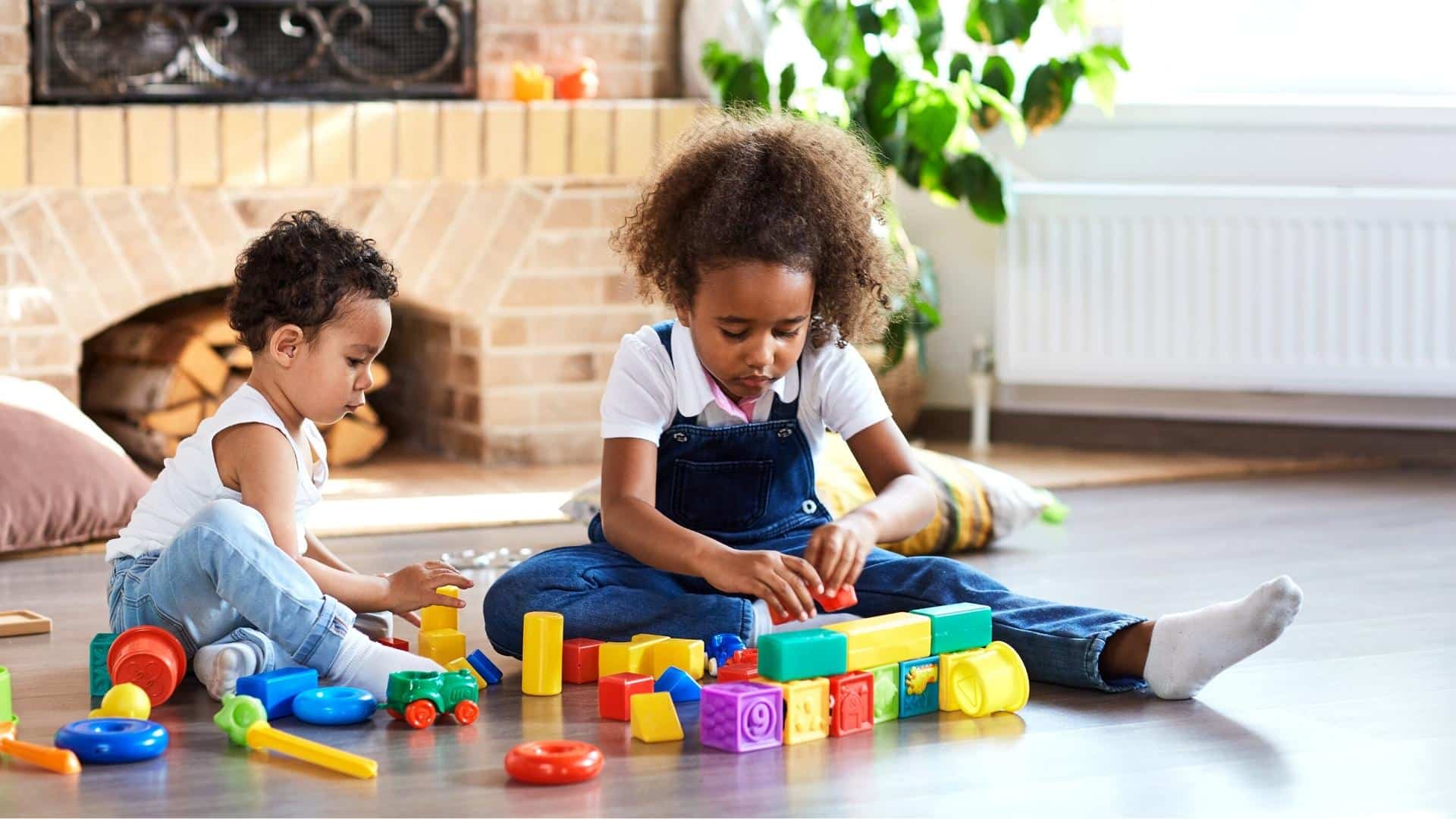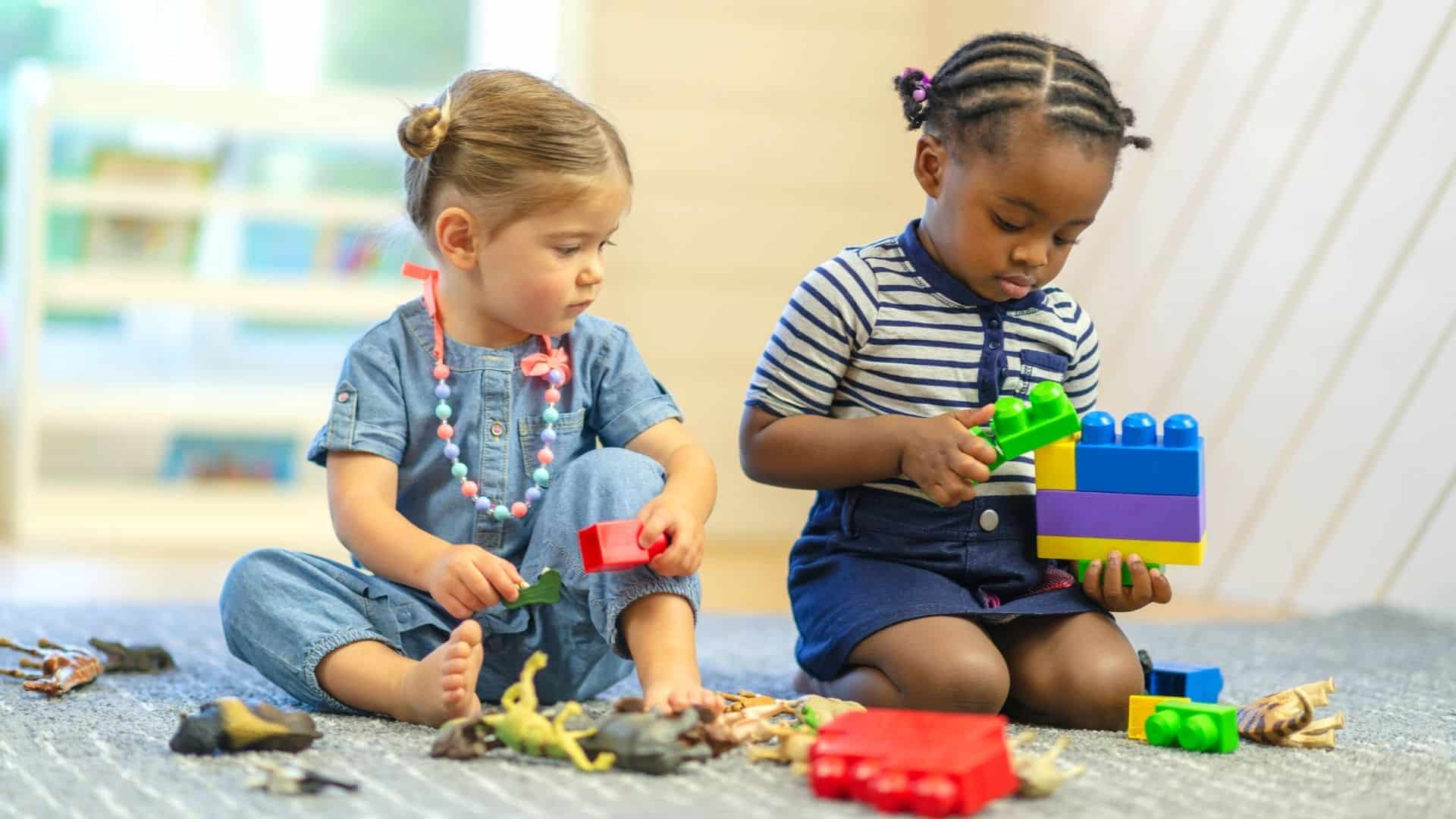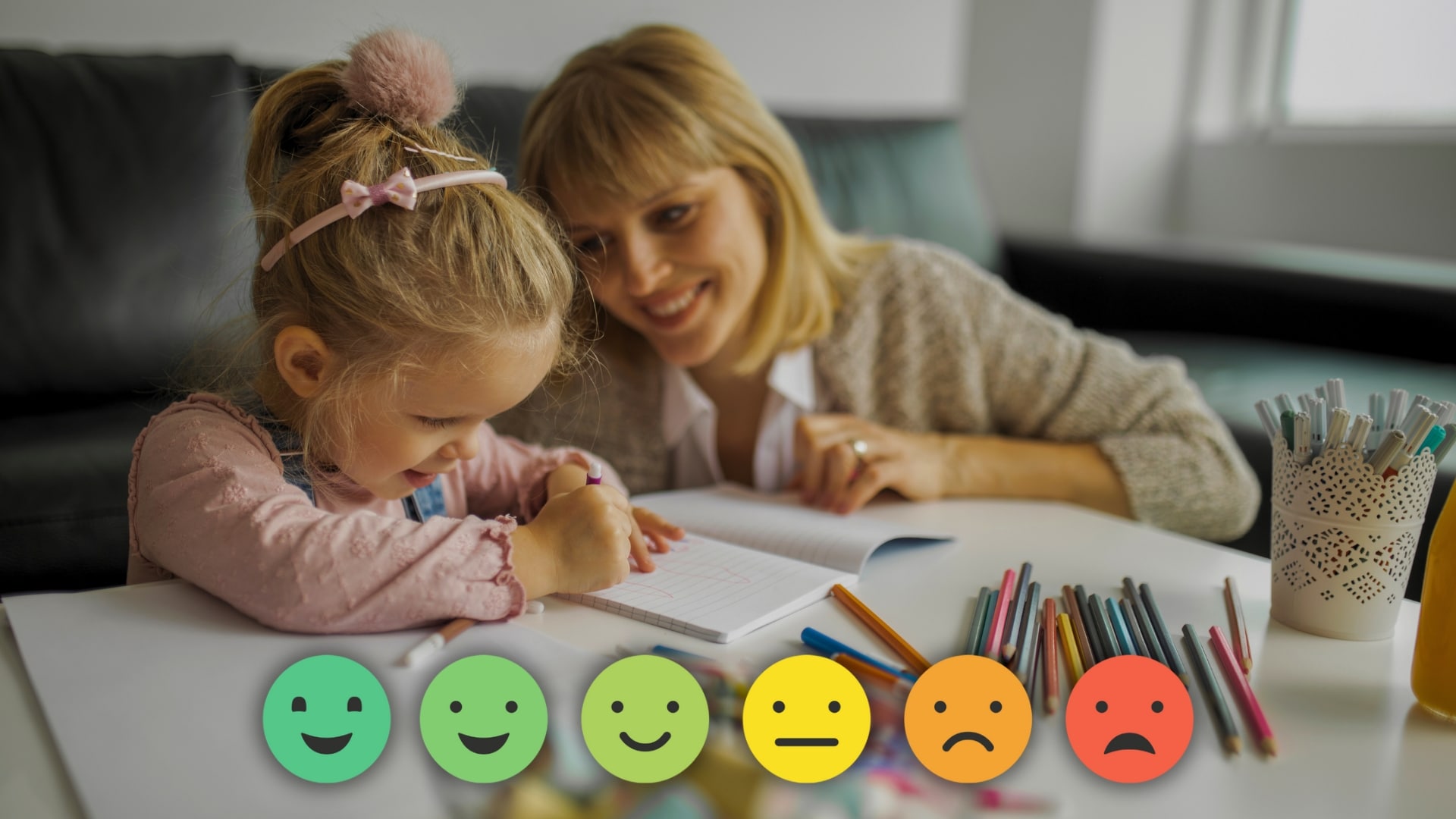Have you ever noticed your toddler watching other people with intense curiosity? This behavior is known as onlooker play, and it’s a vital part of childhood development.
In this article, we’ll explore the benefits of onlooking and provide tips on how to encourage your little one to engage in this type of play. So sit back, relax, and discover how onlooker play can help your child grow and thrive.
What Is Onlooker Play?
Onlooker play is one of the earliest and most crucial developmental stages of the 6 stages of play that children develop through in the early years. Typically during this type of play, children will observe and be intrigued by what others are doing, but they will not engage with them.
The 3 Characteristics Of Onlooker Play
Onlooker play differs from solitary play in that young children now take an active interest in what others are doing, rather than being absorbed in their own play. Despite this, they will still avoid playing with other children.
So how do you identify when your child is engaging in this type of play? Well, here are 3 of the most obvious signs your little one is engaging in onlooking:
- They will stand and watch other children playing from a distance at the park or playgroup.
- They may stand close by and listen to what other children are saying, but not engage in the conversation.
- They might comment on or ask questions about the play they are observing, but they will not actively participate.
A bedtime & nap cheat sheet so good your little one will ask you to put them to bed...
Laura Williams "This is a life saver! I'm so glad I downloaded your bedtime & nap cheat sheet. My little one actually asked me to put him to bed last night! Unbelievable! Thank you so much!"
Click Here For The FREE Cheat Sheet
What Are The 5 Benefits Of Onlooker Play?
The onlooker play stage is hugely important for young children as they learn a great deal from observing how their peers interact with each other. During this type of play, children will also:
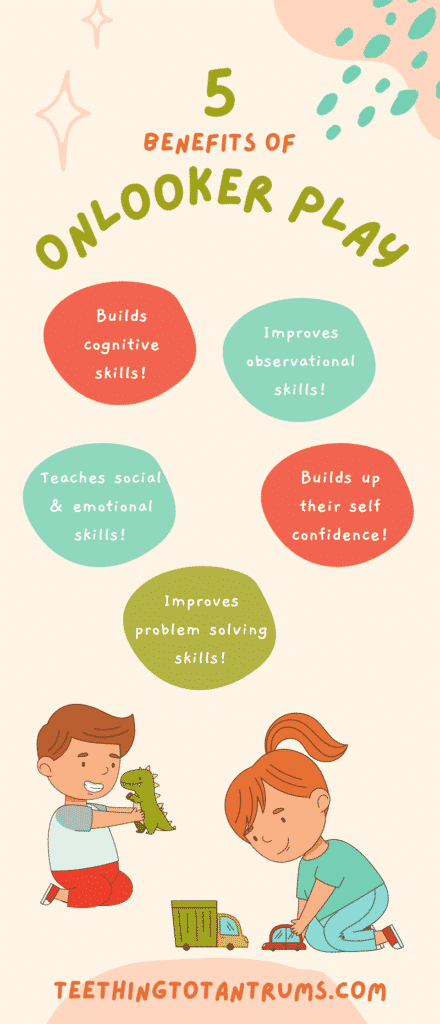
- Build cognitive skills by observing and understanding the actions of others
- Improve their listening skills and observational skills in general
- Improves their language skills and communication skills (even if they’re not directly talking themselves)
- Learn social interaction skills and emotional skills by watching how other children behave
- Build their confidence to begin playing alongside others in the future
- Learn problem-solving and negotiation skills
Examples Of Onlooker Play Activities
Unlike other play stages, onlooker play does not have specific play activities.
It is something that happens naturally when your child stops what they are doing and closely watches what other children are doing. Situations, where you may observe your child engaging in this type of play, are:
- At the park when your toddler will watch other children playing on the equipment
- At daycare or kindergarten observing older children playing
- When your toddler comments on what others are doing
- When watching a group of children playing dress-up
- When they’re at nursery and an older child is building with Lego or other construction blocks and toys
- When they’re at home and an older sibling is painting or playing with playdough
No nursery is complete without wooden blocks. They provide hours of fun and education through play from honing fine motor skills, improving problem-solving, developing creativity and teaching colours and shapes. My favourite is this colourful set from Melissa and Doug.
So to help your child to transition from onlooker play and build their confidence and abilities to interact with other children…
Arrange playdates, take them to the park and join a playgroup and expose them to plenty of new situations and people in a safe and supportive way.
TOP TIP: If your little one appears reluctant to play with others, give them time and space to observe what is going on from a comfortable distance. Try to avoid pushing them to interact with their peers before they are ready.
Games To Support Onlooker Play
As I mentioned earlier… There are no ‘specific’ activities that fall under the title of onlooking as onlooker play is observational rather than active…
However, in order to help your child onto the next stages of play you can encourage them to do the following:
1. Offer Open-Ended Toys To Play
Open-ended toys encourage problem-solving and imagination which are important skills to have when playing with other children.
These city-themed wooden building blocks are a great way to get children to play alongside each other while giving them ample opportunities to watch what other children are doing. They can choose to join in or just comment from the sidelines.
Offering endless possibilities to create a city alongside one another, your toddler and their play companions will love this wooden building block set. BPA-free, lead-free, phthalate-safe and non-toxic, it is also a great choice for parents wanting to choose the best toys for their little ones!
2. Encourage Role Play
Roleplay such as dressing up or having a pretend tea party are great ways to improve your child’s imagination and social skills. And this dressing-up set from Born Toys is great for young toddlers as it will build their confidence and imagination as well provide hours of fun.
Provide the perfect opportunity for your child to imagine, explore and play through the art of role-play with 3 amazing gender-neutral costumes!
3. Play Interactive Games With Your Children
Games that involve simple turn-taking and cooperation between you and your child are perfect for teaching them the art of how to play successfully with others. The Monkey Around Game is great for teaching your toddler gross motor skills, hand-eye coordination, imitation, vocabulary and social-emotional skills through fun play.
Engage with your child through simple and playful Monkey-ing Around fun to boost their gross motor skills, hand-eye coordination, imitation, vocabulary and social-emotional skills!
Common Concerns About Onlooker Play
When our children are engaging in onlooker play we may be tempted to think they are feeling shy or struggling to fit in…
However, this is not always as it seems.
As a parent, we need to concentrate on the benefits of the onlooker stage and appreciate its importance in our little one’s social development.
Don’t try and force your child to interact with other children at this stage.
They are learning invaluable lessons in how to behave in a group of their peers and will gain huge developmental benefits from observing rather than doing. And that in itself should put any concerns about onlooker play at rest.
If, however, you’re still worried about your child’s development and social interactions, I advise seeking out a child development specialist to help answer your concerns and give you peace of mind.
Frequently Asked Questions About Onlooker Play
Looking for more information about onlooker play? Here are the answers to the most common questions.
What Is The Difference Between Onlooker Play And Parallel Play?
Onlooking is the 3rd stage of play that comes BEFORE parallel play in your little one’s development journey.
The main difference between these two types of play is that your child often engages in the same activity but does not play with others in a cooperative manner during parallel play sessions…
While onlooking is an observational development where children watch and learn how others interact and have fun together.
The Six Stages Of Play
Play is an important part of a child’s healthy development. Here’s a quick recap of the 6 types of play you can expect your little one to engage with during the early years.
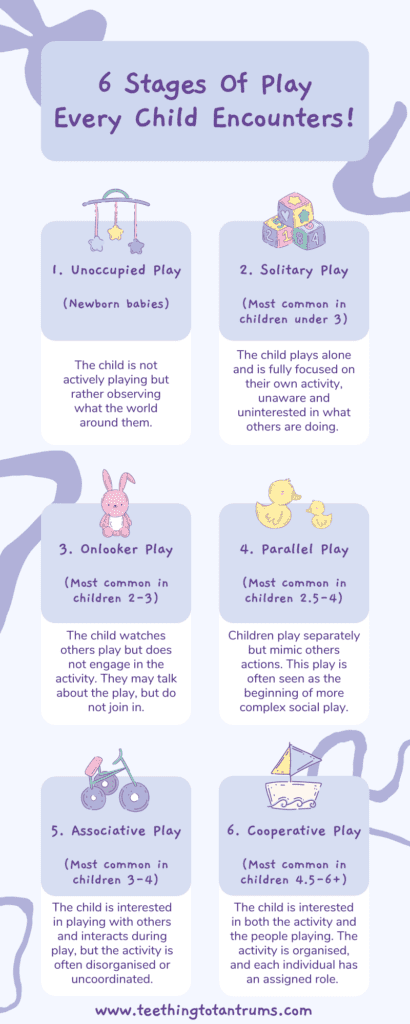
- Unoccupied play stage – Newborn
- Solitary Play stage – 4 months of age and up
- Onlooker Play stage – 2 to 3 years
- Parallel Play stage – 2.5 to 3 years
- Associative Play stage – 3+ years
- Cooperative Play stage – 4 to 5 years
To learn more about Mildred Parten’s 6 stages of play (first developed at the University of Minnesota’s Institute of Child Development), I’ve written an in-depth post talking about each stage and why they’re important for children. So be sure to check that out after reading this post.
Are Spectator Play And Onlooker Play The Same Thing?
Yes, onlooker play and spectator play are exactly the same thing. They are just different ways of labelling the same type of observational play.
At What Age Do Children Engage In Onlooker Play?
Onlooker play is most commonly seen in children between 2 and 3 years of age. However, children will also practise onlooker play throughout most of their childhood.
Need More Parenting Help?
- Download our FREE Bedtime & Nap Sleep Cheat Sheet. It’s a free, easy-to-use and proven formula designed for parents of 0-5 year olds to master the art of consistently undisturbed and restful sleep without the yelling, nagging or exhausting long-winded evenings.
- Check out our Parenting Toolbox. You’ll get access to expertly-chosen products that you can guarantee are the best for your little one and your wallet.
- Are you looking for personalized guidance to navigate the challenges of parenting? I offer 1-on-1 consultations to bring you tailored strategies and actionable advice to help support your child's growth and well-being with confidence.

A bedtime & nap cheat sheet so good your little one will ask you to put them to bed...
Laura Williams "This is a life saver! I'm so glad I downloaded your bedtime & nap cheat sheet. My little one actually asked me to put him to bed last night! Unbelievable! Thank you so much!"
Click Here For The FREE Cheat Sheet




